Giochi dell'Oca e di percorso
(by Luigi Ciompi & Adrian Seville)
(by Luigi Ciompi & Adrian Seville)

|
Giochi dell'Oca e di percorso
(by Luigi Ciompi & Adrian Seville) |

|
 |

Torna alla ricerca giochi (back to game search) |
 |
| Wonders (The) of the World | ||
| Chiefly in Reference to the Architectural Works of the Ancients. An Entirely New Game for the Amusement and Education of Youth | ||
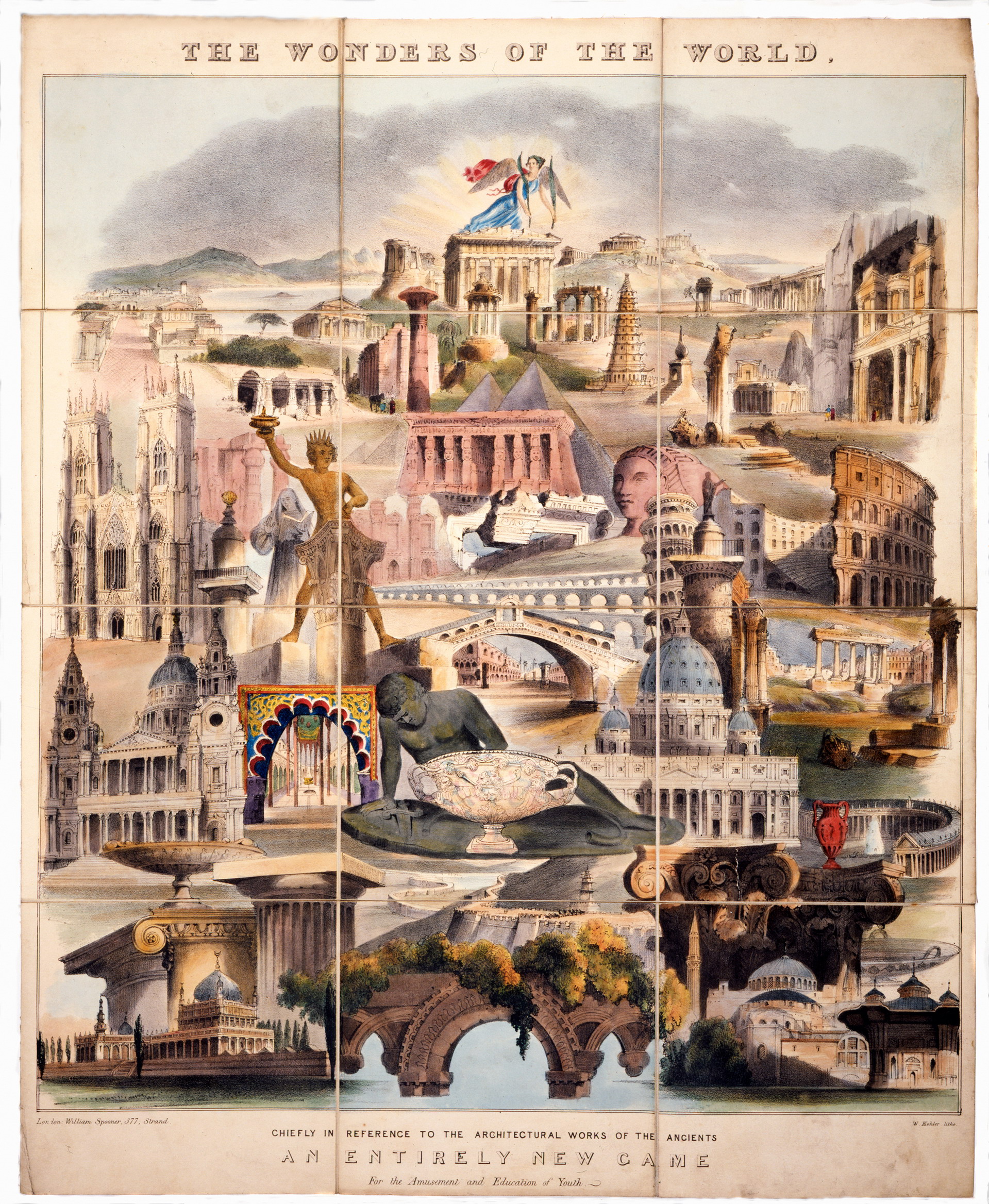 |
Versione stampabile
 |
Invia una segnalazione

|
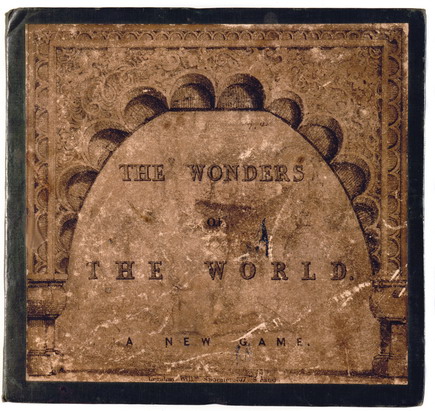 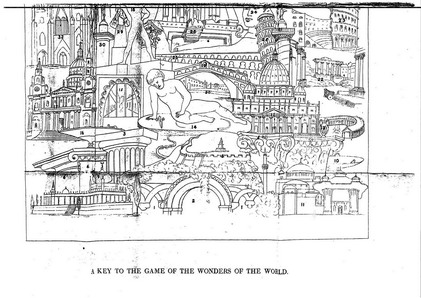 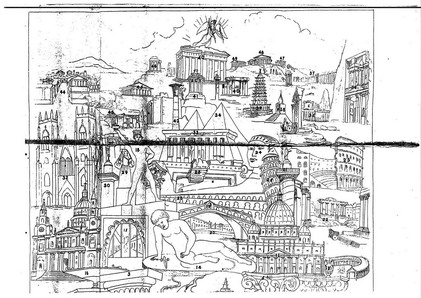 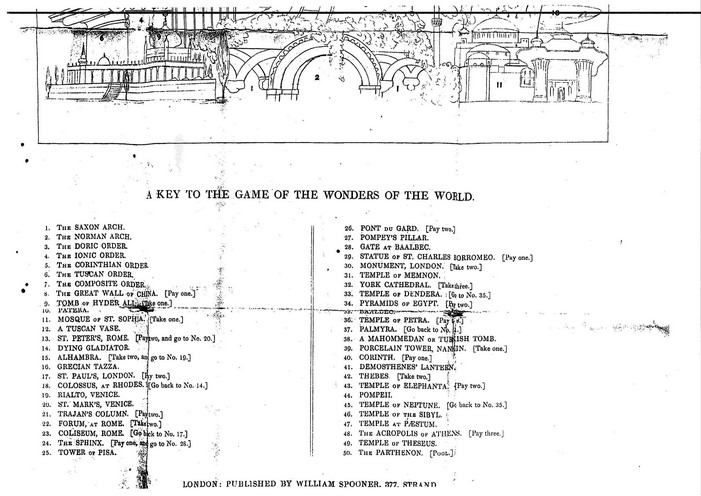 |
primo autore: | Anonimo |
| secondo autore: | Spooner William | |
| anno: | 1843 | |
| luogo: |
Inghilterra-Londra |
|
| periodo: | XIX secolo (?/4) | |
| percorso: | Gioco con i dadi | |
| materiale: | carta incollata su tela (engraving on paper with linen backing) | |
| dimensioni: | 430X540 | |
| stampa: | Litografia colorata a mano (hand-coloured engraving) | |
| luogo acquisto: | ||
| data acquisto: | ||
| dimensioni confezione: | ||
| numero caselle: | 0 | |
| categoria: | Viaggi, escursioni, località, musei, monumenti, turismo | |
| tipo di gioco: | Gioco di percorso | |
| editore: | Spooner William 377 strand. London | |
| stampatore: | Litho. W. Kohler | |
| proprietario: | Collezione E. C. | |
| autore delle foto: | E. C. | |
| numero di catalogo: | 1330 | |
| descrizione: |
Gioco con i dadi. REGOLE: non riportate sul tavoliere. REFERENZA 1 "The Wonders of the World". (V&A Museum). Physical description Design: lithograph, coloured by hand; 12 sections mounted on linen and showing architectural designs N°of squares: none Squares illustrated: overall Square numbering: none Squares titled: in booklet Subject of starting square: ? Subject of ending square: ? Place of Origin: London Date: 1837-1846 Object history note: Playing sheet folds into cloth covered boards with ribbon ties and bearing a label with a lithographed pictorial label. Historical context note Rewards: ? Forfeits: ? N°of Players: any Equipment required: game, markers, booklet Rules: The game is a hand coloured lithograph, 12 panels mounted on linen. The title is at the top and bottom and the publisher's details at the lower left. It shows an overall pictorial image of ancient, classical and more recent archetecture from Egypt, Petra, etc to St. Peter's in Rome and St. Paul's in London. It also includes a brightly coloured Islamic arch possibly Lahambra, Spain. Attached to the top left panel is a folder of card covered with grey cloth and bear a lithographed pictoral label. Title on the game itself: THE WONDERS OF THE WORLD. Chiefly in Reference to the Architectural Works of the Ancients. AN ENTIRELY NEW GAME for the Amusement and Education of Youth. London: Published by William Spooner, 337 Strand. W. Kohler Litho (William Spooner was at this address from 1837 to 1846). Rules placement: booklet Attribution Note: William Spooner, 377 Strand, W. Kohler, Litho. REFERENZA 2 WHITEHOUSE, Francis Reginald Beaman, (pag. 42): WONDERS OF THE WORLD Chiefly in Reference to the Architectural Works of the Ancients. An Entirely New Game for the Amusement and Education of Youth. London. William Spooner, 377 Strand. A coloured lithograph (W. Kohler), size 17 in X 21 in, mounted in 12 sections on linen, bound in hinged covers with picture label on front. A separate key sheet is printed in outline with the names of all the buildings. The rules also are embodied on this sheet, e.g. No 15 Alhambra, Take 2, 34 Pyramids of Egypt, Pay 2. The whole 50 pictures form a race from No 1 The Saxon Arch to No 50 The Parthenon, where the first comer takes the pool. (Not dated, but about 1843 by the address-also the author’s copy of the key sheet is backed with a piece of news sheet of 1845.) REFERENZA 3 "The Wonders of the World!, London: William Spooner, with instruction booklet, ca. 1843, 43 x 54 cm. (Yale University GV1199 .W66 1843.). HOW TO PLAY THE GAME: This board depicts examples of ancient, classical, and more recent architectural sites, including Petra, Alhambra, Leaning Tower of Pisa, St. Peter’s in Rome, and St. Paul’s in London. Printed purposely without numbered spaces, the game forced a player to study the text of the accompanying booklet before a move could be made, for “in so doing, his memory will become impressed with the name and character of the object he has to seek.” The first player to land on the image of the Parthenon - at the top of the board - would win the game. (Patrons) Exhibitions: - "Instruction and Delight: Children's Games from the Ellen and Arthur Liman Collection" (Yale Center for British Art, 17 January-23 May, 2019). |
|
| bibliografia: |
1) WHITEHAUSE, F.R.B.: "Table Games of Georgian and Victorian Days", London, Peter Garnett, 1951. 2) GOODFELLOW, Caroline: "A Collector's Guide to Games and Puzzles". Secaucus, New Jersey, Chartwell Books-London, Quintet Publishing Limited 1991. 3) GOODFELLOW, Caroline: "The Development of the English Board Game, 1770-1850", in Board Games Studies 1, 1998. 4) GOODFELLOW, Caroline: "Jeux de société. Le guide du collectionneur des jeux de société depuis le XVIIIe siècle jusqu’à nos jours", (Edizione francese) Carrousel MS, 2001. 5) SEVILLE, Adrian: "The Game of Goose: and its influence on cartographical race games" Journal of the International Map Collectors' Society, Winter 2008 N°115 2008. 6) SEVILLE, Adrian: "The geographical Jeux de l'Oie of Europe." In "Belgeo" 2008 3-4 2008. 7) GOODFELLOW, Caroline: "How We Played: Games From Childhood Past", History Press, 2012. 8) QUINN, Brian - CARTWRIGHT, William: "Geographic Board Games". Geospatial Science Research 3. School of Mathematical and Geospatial Science, RMIT University, Australia. December 2014. 9) SEVILLE, Adrian: "The Royal Game of the Goose four hundred years of printed Board Games". Catalogue of an Exhibition at the Grolier Club, February 23 - May 14, 2016. 10) LIMAN, Ellen: "Georgian and Victorian Board Games: The Liman Collection", Pointed Leaf Press, 2017. 11) NORCIA, Megan A.: "Gaming Empire in Children's British Board Games, 1836-1860". Studies in Childhood, 1700 to the Present. Routledge, 2019. 12) SEVILLE, Adrian: "L'arte dei giochi da tavolo. Oltre un secolo di storia e divertimento dalla fine del Settecento all'inizio del Novecento." Edizioni White Star, 2019. 13) PARLAK, Omer Fatih: "Seafearing through the Perspective of Historic Board Games", in DGSM, Köllen Druck+Verlag, Bonn 2020. |
|
| "The Development of the English Board Game, 1770-1850" (Caroline G. Goodfellow) | ||
| Instructional Games. "Table Games of Georgian and Victorian Days". (Francis Reginald Beaman, Whitehause) | ||
Vai alla ricerca giochi Vai all'elenco autori